The Impact of Hydrogeological Features on the Performance of Underground Pumped-Storage Hydropower (UPSH)
Abstract
:Featured Application
Abstract
1. Introduction
2. Materials and Methods
2.1. Problem Statement
2.2. Description of the Numerical Model
2.2.1. Code
2.2.2. Characteristics of the Model
2.2.3. Simulated Scenarios
2.2.4. Methodology Limitation
3. Results and Discussion
3.1. Non-Dischargeable Volume of Water (Difference between Pumped and Discharge Water)
3.1.1. TOP Scenarios (Influence of k)
3.1.2. MIDDLE Scenarios (Influence of k)
3.1.3. Influence of the Piezometric Head Elevation
3.2. Variations in
3.3. Previous Works and Future Investigations
4. Conclusions
- The K of the surrounding medium drove the groundwater exchanges. Consequently, K played an important role concerning the of UPSH and its associated environmental impacts. Thus, K should be considered in the selection process of abandoned mines when constructing future UPSH plants.
- The influence exerted by K depended on the elevation of the piezometric head with respect to the mine. If the piezometric head was located at a high elevation, high values of K were harmful for the and the environmental impacts. When the natural piezometric head was located at the half elevation of the mine, the K did not affect the of UPSH nor the environmental impacts over surface water bodies; however, the impact could become important in terms of the groundwater quality, increasing with high values of K.
- The elevation of the piezometric head was relevant and must be considered when designing an UPSH plant. The results showed that, for the same values of K, the was higher, and the environmental impacts over surface water bodies were lower if the piezometric head was located at a low elevation. However, the potential impacts on the groundwater increased, since the outflows from the underground reservoir to the surrounding geological medium increased with low piezometric heads. Consequently, an agreement between the , the environmental impacts into surface water bodies, and those generated in nearby aquifer systems will be needed in order to choose potential sites to implement UPSH.
Author Contributions
Funding
Institutional Review Board Statement
Informed Consent Statement
Data Availability Statement
Conflicts of Interest
References
- Hu, Y.; Bie, Z.; Ding, T.; Lin, Y. An NSGA-II Based Multi-Objective Optimization for Combined Gas and Electricity Network Expansion Planning. Appl. Energy 2016, 167, 280–293. [Google Scholar] [CrossRef] [Green Version]
- Mileva, A.; Johnston, J.; Nelson, J.H.; Kammen, D.M. Power System Balancing for Deep Decarbonization of the Electricity Sector. Appl. Energy 2016, 162, 1001–1009. [Google Scholar] [CrossRef] [Green Version]
- Okazaki, T.; Shirai, Y.; Nakamura, T. Concept Study of Wind Power Utilizing Direct Thermal Energy Conversion and Thermal Energy Storage. Renew. Energy 2015, 83, 332–338. [Google Scholar] [CrossRef] [Green Version]
- Menéndez, J.; Fernández-Oro, J.M.; Loredo, J. Economic Feasibility of Underground Pumped Storage Hydropower Plants Providing Ancillary Services. Appl. Sci. 2020, 10, 3947. [Google Scholar] [CrossRef]
- Gebretsadik, Y.; Fant, C.; Strzepek, K.; Arndt, C. Optimized Reservoir Operation Model of Regional Wind and Hydro Power Integration Case Study: Zambezi Basin and South Africa. Appl. Energy 2016, 161, 574–582. [Google Scholar] [CrossRef] [Green Version]
- Delfanti, M.; Falabretti, D.; Merlo, M. Energy Storage for PV Power Plant Dispatching. Renew. Energy 2015, 80, 61–72. [Google Scholar] [CrossRef]
- Zhang, N.; Lu, X.; McElroy, M.B.; Nielsen, C.P.; Chen, X.; Deng, Y.; Kang, C. Reducing Curtailment of Wind Electricity in China by Employing Electric Boilers for Heat and Pumped Hydro for Energy Storage. Appl. Energy 2016, 184, 987–994. [Google Scholar] [CrossRef] [Green Version]
- Steffen, B. Prospects for Pumped-Hydro Storage in Germany. Energy Policy 2012, 45, 420–429. [Google Scholar] [CrossRef] [Green Version]
- Pumped-Storage Hydropower. Available online: https://www.energy.gov/eere/water/pumped-storage-hydropower (accessed on 8 October 2020).
- Menéndez, J.; Fernández-Oro, J.M.; Galdo, M.; Loredo, J. Efficiency Analysis of Underground Pumped Storage Hydropower Plants. J. Energy Storage 2020, 28, 101234. [Google Scholar] [CrossRef]
- Hadjipaschalis, I.; Poullikkas, A.; Efthimiou, V. Overview of Current and Future Energy Storage Technologies for Electric Power Applications. Renew. Sustain. Energy Rev. 2009, 13, 1513–1522. [Google Scholar] [CrossRef]
- Wong, I.H. An Underground Pumped Storage Scheme in the Bukit Timah Granite of Singapore. Tunn. Undergr. Space Technol. 1996, 11, 485–489. [Google Scholar] [CrossRef]
- Menéndez, J.; Fernández-Oro, J.M.; Galdo, M.; Loredo, J. Transient Simulation of Underground Pumped Storage Hydropower Plants Operating in Pumping Mode. Energies 2020, 13, 1781. [Google Scholar] [CrossRef] [Green Version]
- Menéndez, J.; Schmidt, F.; Konietzky, H.; Fernández-Oro, J.M.; Galdo, M.; Loredo, J.; Díaz-Aguado, M.B. Stability Analysis of the Underground Infrastructure for Pumped Storage Hydropower Plants in Closed Coal Mines. Energies 2019, 94, 103117. [Google Scholar] [CrossRef]
- Mueller, S.C.; Sandner, P.G.; Welpe, I.M. Monitoring Innovation in Electrochemical Energy Storage Technologies: A Patent-Based Approach. Appl. Energy 2015, 137, 537–544. [Google Scholar] [CrossRef] [Green Version]
- Pujades, E.; Willems, T.; Bodeux, S.; Orban, P.; Dassargues, A. Underground Pumped Storage Hydroelectricity Using Abandoned Works (Deep Mines or Open Pits) and the Impact on Groundwater Flow. Hydrogeol. J. 2016, 24, 1531–1546. [Google Scholar] [CrossRef] [Green Version]
- Uddin, N.; Asce, M. Preliminary Design of an Underground Reservoir for Pumped Storage. Geotech. Geol. Eng. 2003, 21, 331–355. [Google Scholar] [CrossRef]
- Kuriqi, A.; Pinheiro, A.N.; Sordo-Ward, A.; Garrote, L. Water-Energy-Ecosystem Nexus: Balancing Competing Interests at a Run-of-River Hydropower Plant Coupling a Hydrologic–Ecohydraulic Approach. Energy Convers. Manage. 2020, 223, 113267. [Google Scholar] [CrossRef]
- Suwal, N.; Huang, X.; Kuriqi, A.; Chen, Y.; Pandey, K.P.; Bhattarai, K.P. Optimisation of Cascade Reservoir Operation Considering Environmental Flows for Different Environmental Management Classes. Renew. Energy 2020, 158, 453–464. [Google Scholar] [CrossRef]
- Menéndez, J.; Schmidt, F.; Konietzky, H.; Bernardo Sánchez, A.; Loredo, J. Empirical Analysis and Geomechanical Modelling of an Underground Water Reservoir for Hydroelectric Power Plants. Appl. Sci. 2020, 10, 5853. [Google Scholar] [CrossRef]
- Madlener, R.; Specht, J.M. An Exploratory Economic Analysis of Underground Pumped-Storage Hydro Power Plants in Abandoned Coal Mines. SSRN J. 2013. [Google Scholar] [CrossRef] [Green Version]
- Bodeux, S.; Pujades, E.; Orban, P.; Brouyère, S.; Dassargues, A. Interactions between Groundwater and the Cavity of an Old Slate Mine Used as Lower Reservoir of an UPSH (Underground Pumped Storage Hydroelectricity): A Modelling Approach. Eng. Geol. 2017, 217, 71–80. [Google Scholar] [CrossRef] [Green Version]
- Menéndez, J.; Ordóñez, A.; Álvarez, R.; Loredo, J. Energy from Closed Mines: Underground Energy Storage and Geothermal Applications. Renew. Sustain. Energy Rev. 2019, 108, 498–512. [Google Scholar] [CrossRef]
- Références et projets|BRGM. Available online: https://www.brgm.fr/fr/resultats-donnees/references-projets (accessed on 18 January 2021).
- Poty, E.; Chevalier, E. Wallonie L’activité Extractive En Wallonie: Situation Actuelle et Perspectives; Laboratoire d’analyses litho et zoostratigraphiques: Liège, Belgium, 2004. [Google Scholar]
- Gombert, P.; Poulain, A.; Goderniaux, P.; Orban, P.; Pujades, E.; Dassargues, A. Potentiel de valorisation de sites miniers et carriers en step en France et en Belgique. LHB 2020, 4, 33–42. [Google Scholar] [CrossRef]
- Poulain, A. Etude de l’impact Sollicitations Cycliques Au Sein d’aquifères Non Confinés, à Différentes Échelles. Applications à Des Systèmes de Pompage–Turbinage En Carrières, Université de Mons. 2018. Available online: https://web.umons.ac.be/fpms/fr/evenements/etude-de-limpact-de-sollicitations-cycliques-au-sein-daquiferes-non-confines-a-differentes-echelles-applications-a-des-systemes-de-pompage-turbinage-en-carrieres-par/ (accessed on 18 January 2021).
- Poulain, A.; Goderniaux, P.; de dreuzy, J.-R. Study of Groundwater-Quarry Interactions in the Context of Energy Storage Systems. 2016, 18, EPSC2016-9055. Available online: https://orbi.uliege.be/handle/2268/217789 (accessed on 18 January 2021).
- Pujades, E.; Jurado, A.; Orban, P.; Ayora, C.; Poulain, A.; Goderniaux, P.; Brouyère, S.; Dassargues, A. Hydrochemical Changes Induced by Underground Pumped Storage Hydropower and Their Associated Impacts. J. Hydrol. 2018, 563, 927–941. [Google Scholar] [CrossRef] [Green Version]
- Pujades, E.; Jurado, A.; Orban, P.; Dassargues, A. Parametric Assessment of Hydrochemical Changes Associated to Underground Pumped Hydropower Storage. Sci. Total Environ. 2019, 659, 599–611. [Google Scholar] [CrossRef] [Green Version]
- Pujades, E.; Orban, P.; Jurado, A.; Ayora, C.; Brouyère, S.; Dassargues, A. Water Chemical Evolution in Underground Pumped Storage Hydropower Plants and Induced Consequences. Energy Procedia 2017, 125, 504–510. [Google Scholar] [CrossRef]
- Pujades, E.; Orban, P.; Bodeux, S.; Archambeau, P.; Erpicum, S.; Dassargues, A. Underground Pumped Storage Hydropower Plants Using Open Pit Mines: How Do Groundwater Exchanges Influence the Efficiency? Appl. Energy 2017, 190, 135–146. [Google Scholar] [CrossRef]
- Pujades, E.; Orban, P.; Archambeau, P.; Kitsikoudis, V.; Erpicum, S.; Dassargues, A. Underground Pumped-Storage Hydropower (UPSH) at the Martelange Mine (Belgium): Interactions with Groundwater Flow. Energies 2020, 13, 2353. [Google Scholar] [CrossRef]
- Water Framework Directive. Available online: https://eur-lex.europa.eu/eli/dir/2000/60/oj (accessed on 4 February 2021).
- Anciaux, V. The Ardennes–Slate Throughout. de Leekëppert, Bulletin de Liaison 2019, 5. Available online: http://www.ardoise.lu/wp/wp-content/uploads/2019/11/2019-ARDENNES_1_AnciauxThilmany-VERSION-ANGLAISE-FINAL.pdf (accessed on 18 January 2021).
- Bouezmarni, M.; Denne, P.; Debbaut, V. Carte hydrogéologique de Wallonie 1/25000. 65/3-4, Bastogne–Wardin et 65/7-8 Fauvillers–Romeldange. 2006. Available online: http://hdl.handle.net/2268/98657 (accessed on 18 January 2021).
- Bear, J.; Cheng, A.H.-D. Modeling Groundwater Flow and Contaminant Transport; Theory and Applications of Transport in Porous Media; Springer: Dordrecht, Netherlands, 2010. [Google Scholar]
- Erpicum, S.; Archambeau, P.; Dewals, B.; Pirotton, M.; Pujades, E.; Orban, P.; Dassargues, A.; Cerfontaine, B.; Charlier, R.; Poulain, A.; et al. Underground Pumped Hydro-Energy Storage in Wallonia (Belgium) Using Old Mines–Potential and Challenges. 2017, 2984–2991. Available online: http://hdl.handle.net/2268/214205 (accessed on 18 January 2021).
- Brouyère, S.; Orban, P.; Wildemeersch, S.; Couturier, J.; Gardin, N.; Dassargues, A. The Hybrid Finite Element Mixing Cell Method: A New Flexible Method for Modelling Mine Ground Water Problems. Mine Water Environ. 2009, 28, 102–114. [Google Scholar] [CrossRef] [Green Version]
- Wildemeersch, S.; Brouyère, S.; Orban, P.; Couturier, J.; Dingelstadt, C.; Veschkens, M.; Dassargues, A. Application of the Hybrid Finite Element Mixing Cell Method to an Abandoned Coalfield in Belgium. J. Hydrol. 2010, 392, 188–200. [Google Scholar] [CrossRef] [Green Version]
- Celia, M.A.; Bouloutas, E.T.; Zarba, R.L. A General Mass-Conservative Numerical Solution for the Unsaturated Flow Equation. Water Resour. Res. 1990, 26, 1483–1496. [Google Scholar] [CrossRef]
- Dassargues, A. Hydrogeology: Groundwater Science and Engineering; CRC Press: Raton, FL, USA, 2018; ISBN 0-429-89440-6. [Google Scholar]
- Yeh, G.T.; Cheng, J.R.; Cheng, H.P. 3DFEMFAT: A 3-Dimensional Finite Element Model of Density-Dependent Flow and Transport through Saturated-Unsaturated Media; Department of Civil and Environmental Engineering, Pennsylvania State University: University Park, PA, USA, 1994. [Google Scholar]
- Brouyère, S. Etude et Modélisation du Transport et du Piégeage des Solutés en Milieu Souterrain Variablement Saturé. Evaluation des Paramètres Hydrodispersifs par la Réalisation et L’interprétation D’essais de Traçage in Situ. Doctoral Thesis, Université de Liège, Sart Tilman, Belgique, 18 December 2001. [Google Scholar]
- Brouyère, S.; Carabin, G.; Dassargues, A. Climate Change Impacts on Groundwater Resources: Modelled Deficits in a Chalky Aquifer, Geer Basin, Belgium. Hydrogeol. J. 2004, 12, 123–134. [Google Scholar] [CrossRef] [Green Version]
- Carabin, G.; Dassargues, A. Modeling Groundwater with Ocean and River Interaction. Water Resour. Res. 1999, 35, 2347–2358. [Google Scholar] [CrossRef]
- Orban, P.; Brouyère, S. Groundwater Flow and Transport Delivered for Groundwater Quality Trend Forecasting by TREND T2. 2006. Available online: http://hdl.handle.net/2268/78481 (accessed on 18 January 2021).
- Scanlon, B.R.; Mace, R.E.; Barrett, M.E.; Smith, B. Can We Simulate Regional Groundwater Flow in a Karst System Using Equivalent Porous Media Models? Case Study, Barton Springs Edwards Aquifer, USA. J. Hydrol. 2003, 276, 137–158. [Google Scholar] [CrossRef]
- Hassan, S.M.T.; Lubczynski, M.W.; Niswonger, R.G.; Su, Z. Surface–Groundwater Interactions in Hard Rocks in Sardon Catchment of Western Spain: An Integrated Modeling Approach. J. Hydrol. 2014, 517, 390–410. [Google Scholar] [CrossRef]
- Kitsikoudis, V.; Archambeau, P.; Dewals, B.; Pujades, E.; Orban, P.; Dassargues, A.; Pirotton, M.; Erpicum, S. Underground Pumped-Storage Hydropower (UPSH) at the Martelange Mine (Belgium): Underground Reservoir Hydraulics. Energies 2020, 13, 3512. [Google Scholar] [CrossRef]
- Suwal, N.; Kuriqi, A.; Huang, X.; Delgado, J.; Młyński, D.; Walega, A. Environmental Flows Assessment in Nepal: The Case of Kaligandaki River. Sustainability 2020, 12, 8766. [Google Scholar] [CrossRef]
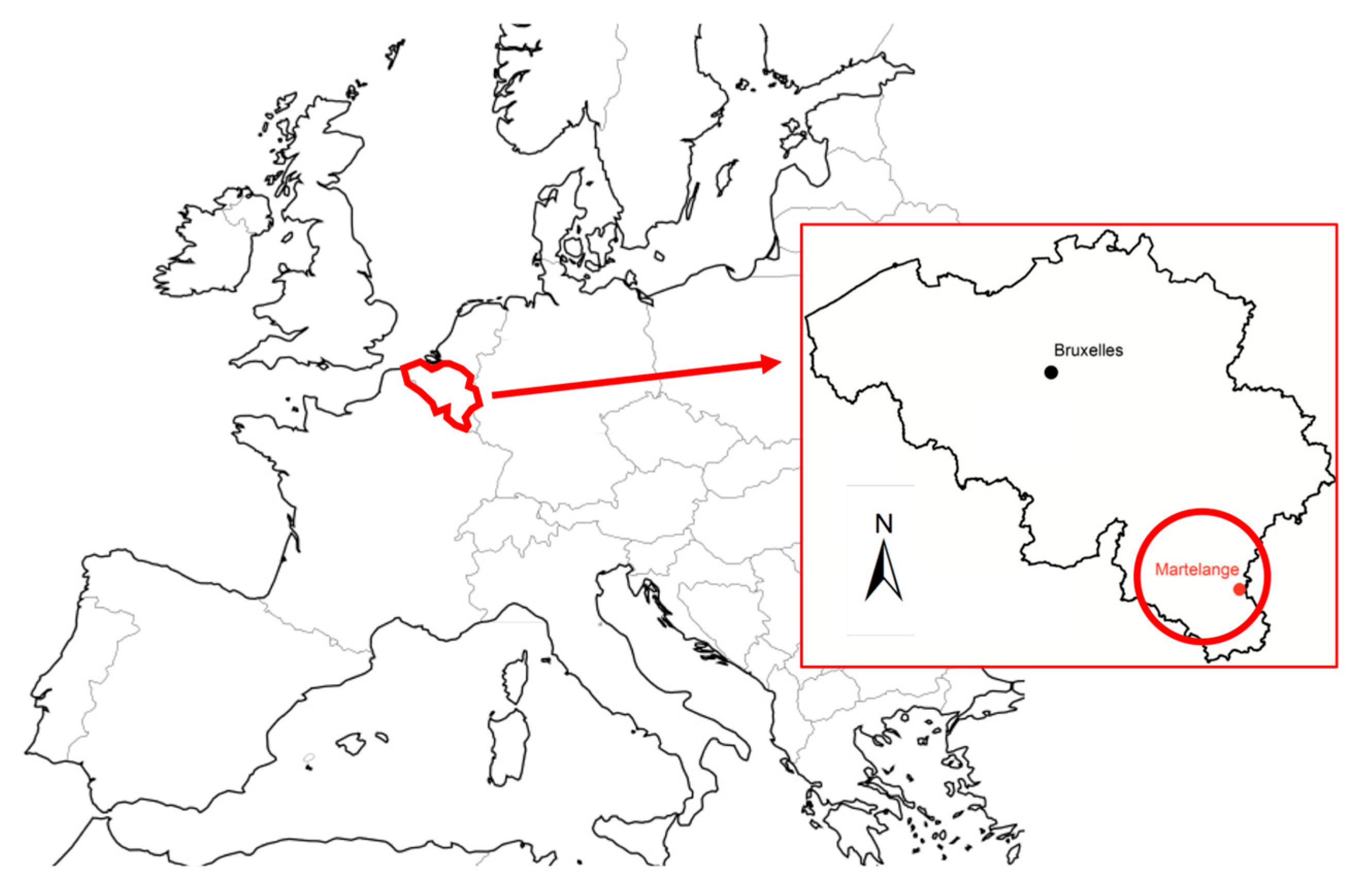
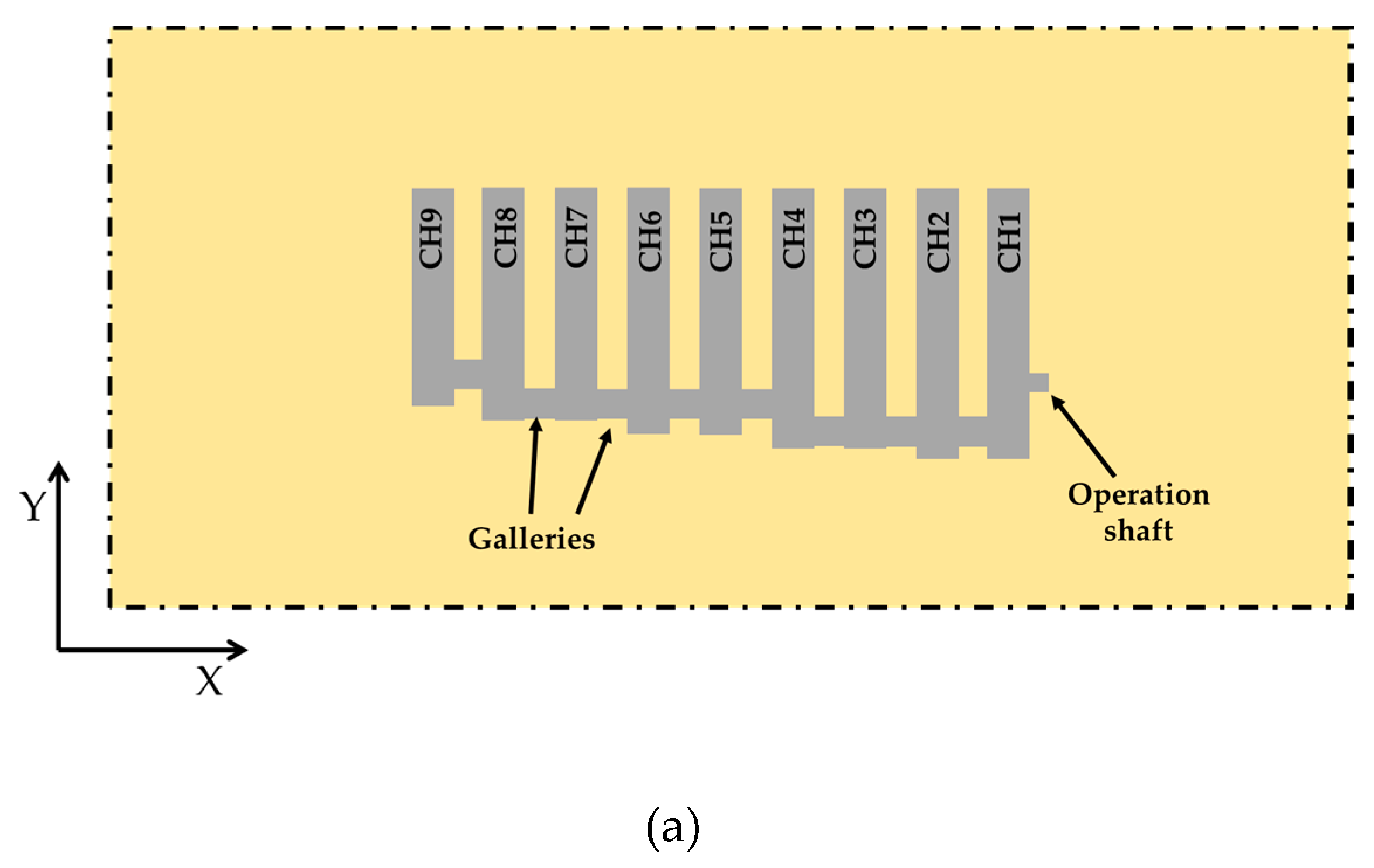
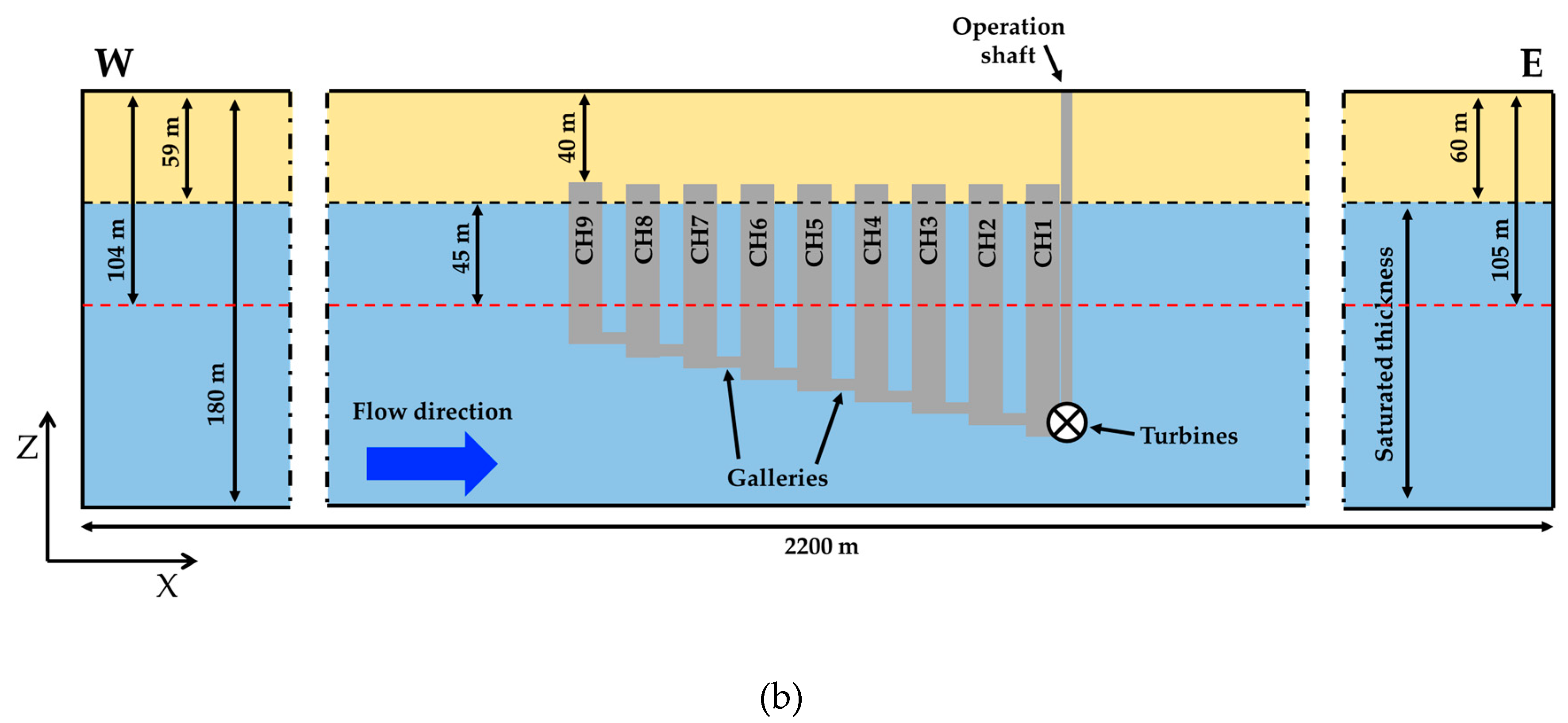
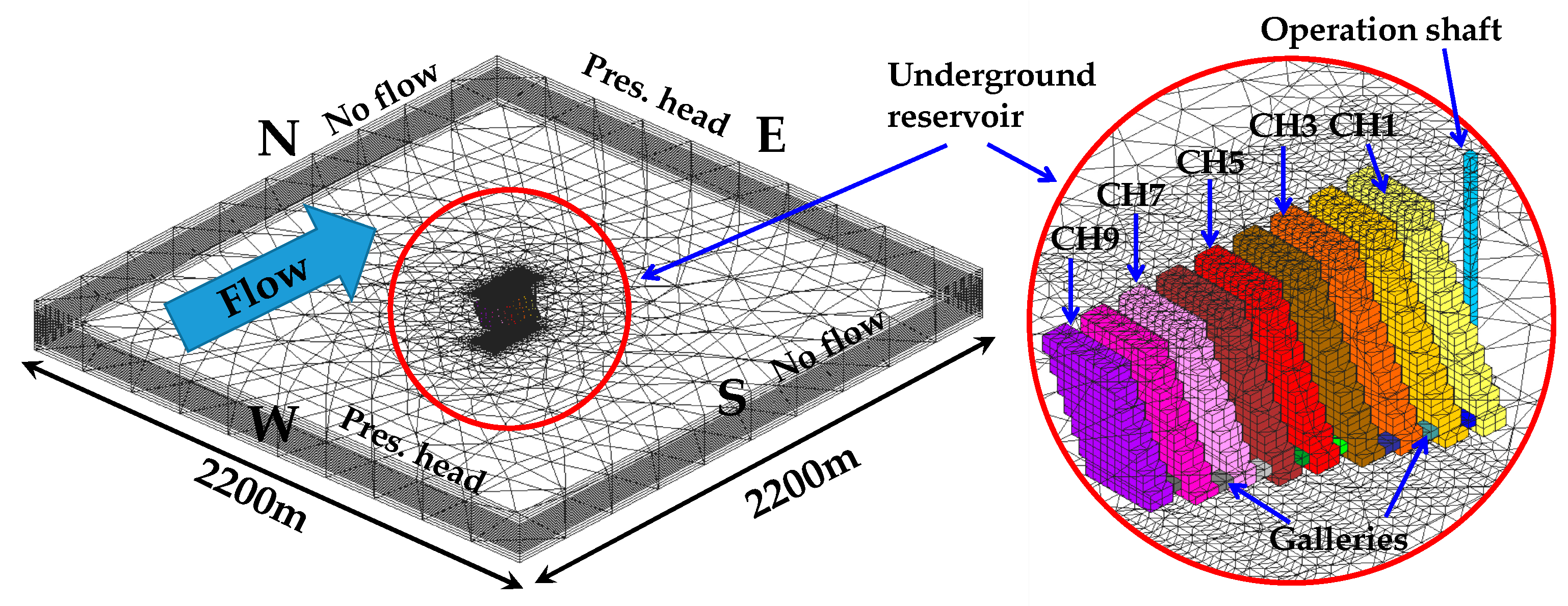

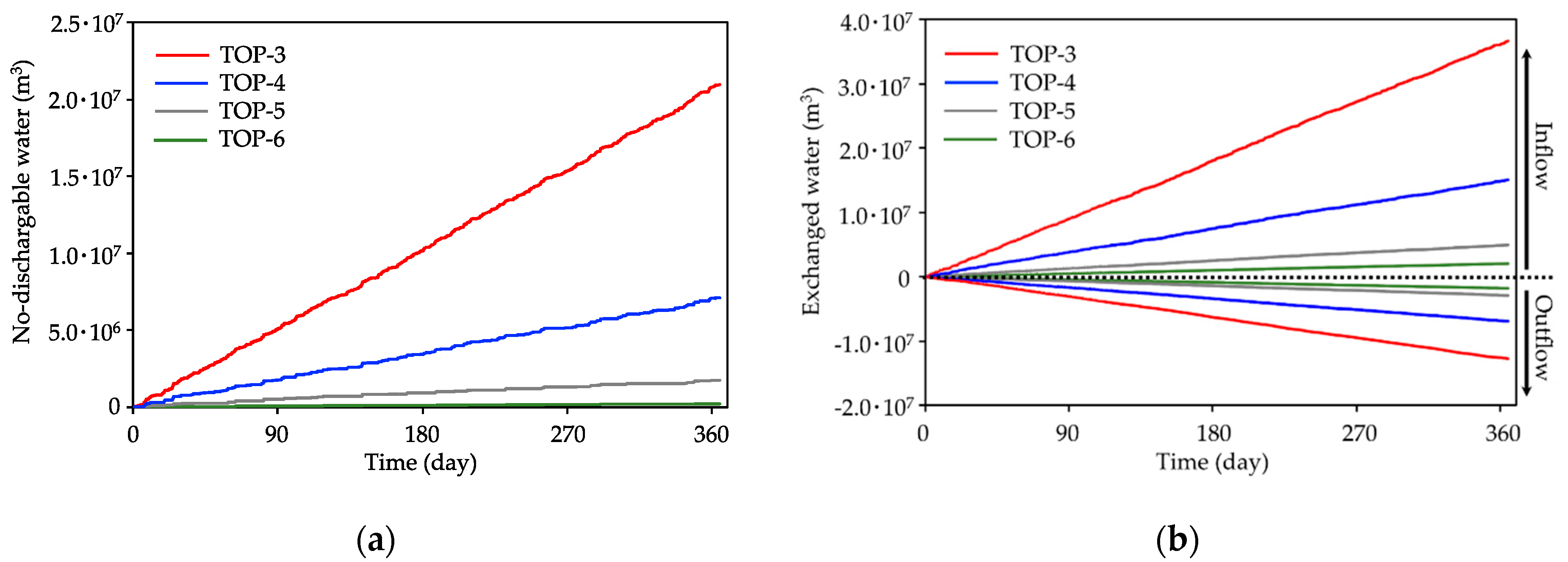
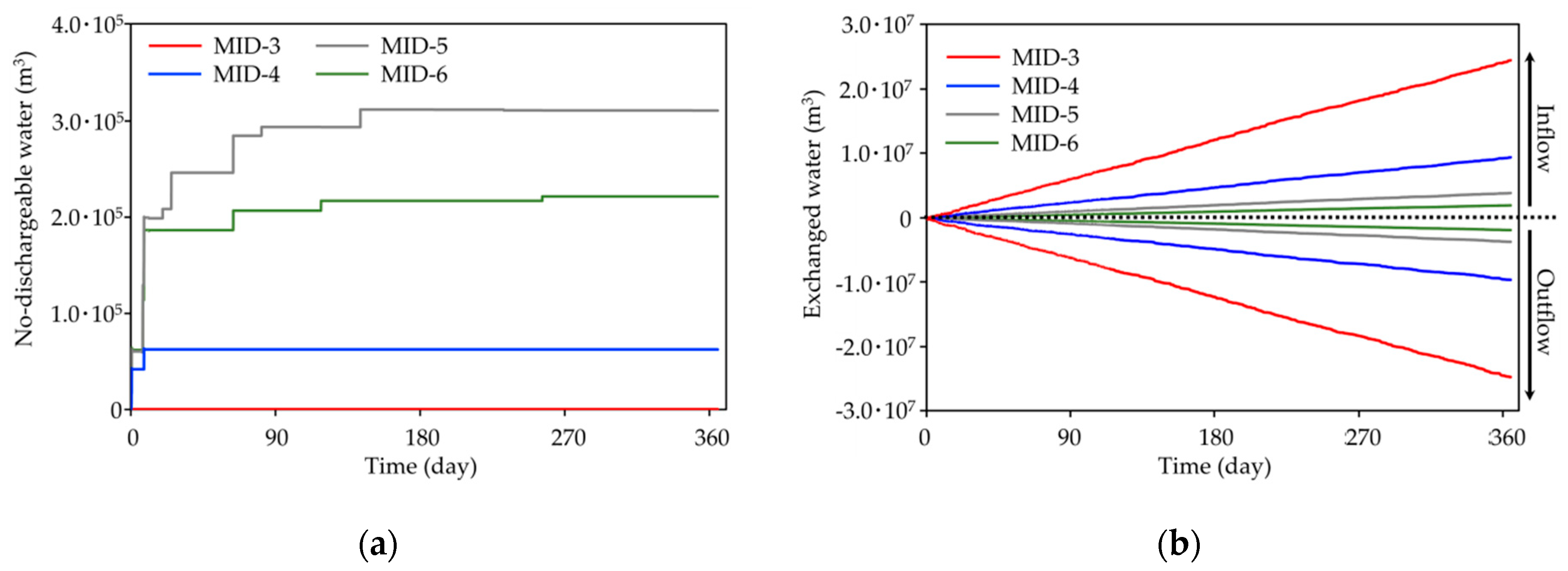
| TOP Scenario | MIDDLE Scenario | ||
|---|---|---|---|
| TOP-3 | −37.3 | MID-3 | 0 |
| TOP-4 | −12.6 | MID-4 | −0.1 |
| TOP-5 | −3.1 | MID-5 | −0.6 |
| TOP-6 | −0.4 | MID-6 | −0.4 |
Publisher’s Note: MDPI stays neutral with regard to jurisdictional claims in published maps and institutional affiliations. |
© 2021 by the authors. Licensee MDPI, Basel, Switzerland. This article is an open access article distributed under the terms and conditions of the Creative Commons Attribution (CC BY) license (http://creativecommons.org/licenses/by/4.0/).
Share and Cite
Pujades, E.; Poulain, A.; Orban, P.; Goderniaux, P.; Dassargues, A. The Impact of Hydrogeological Features on the Performance of Underground Pumped-Storage Hydropower (UPSH). Appl. Sci. 2021, 11, 1760. https://doi.org/10.3390/app11041760
Pujades E, Poulain A, Orban P, Goderniaux P, Dassargues A. The Impact of Hydrogeological Features on the Performance of Underground Pumped-Storage Hydropower (UPSH). Applied Sciences. 2021; 11(4):1760. https://doi.org/10.3390/app11041760
Chicago/Turabian StylePujades, Estanislao, Angelique Poulain, Philippe Orban, Pascal Goderniaux, and Alain Dassargues. 2021. "The Impact of Hydrogeological Features on the Performance of Underground Pumped-Storage Hydropower (UPSH)" Applied Sciences 11, no. 4: 1760. https://doi.org/10.3390/app11041760
APA StylePujades, E., Poulain, A., Orban, P., Goderniaux, P., & Dassargues, A. (2021). The Impact of Hydrogeological Features on the Performance of Underground Pumped-Storage Hydropower (UPSH). Applied Sciences, 11(4), 1760. https://doi.org/10.3390/app11041760







